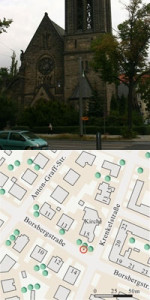 On 20 November 1929, Ursula Heidrich, who had been born the previous day, was christened in Dresden’s Sacred Heart Church. Spastic paralysis developed in the girl’s legs and prevented her from learning to walk. When Ursula was six years old, the Dresden Municipal Welfare Agency decided to institutionalise her at Katharinenhof in Großhennersdorf, an institution of the Innere Mission (a social service organisation of the Protestant Church).
On 20 November 1929, Ursula Heidrich, who had been born the previous day, was christened in Dresden’s Sacred Heart Church. Spastic paralysis developed in the girl’s legs and prevented her from learning to walk. When Ursula was six years old, the Dresden Municipal Welfare Agency decided to institutionalise her at Katharinenhof in Großhennersdorf, an institution of the Innere Mission (a social service organisation of the Protestant Church).
Beginning in the autumn of 1939, central agencies of the NSDAP organised the systematic killing of ill and disabled people, one reason being to create hospital capacity for the Wehrmacht. In the following months, all the residents of homes for the disabled were examined and selected to be killed. At first Ursula Heidrich was spared from being murdered, while most of the residents at Katharinenhof were gassed in the killing centre at Pirna-Sonnenstein. The mass gassings were completed in August 1941, but the murder campaigns were continued until the end of the war in a covert and decentralised way in selected hospitals and nursing institutions.
One of these was the institution run by the state of Saxony at Großschweidnitz to which Ursula Heidrich was transferred in 1943. In the previous years, the sensitive, cheerful girl had learned to read and write. At her request, she was confirmed in Großschweidnitz.
In February 1945, Ursula was killed at the institution. After continuous malnourishment had weakened her immune system, she was given a high dose of sleeping medication that paralysed her coughing and swallowing reflexes. This was done to induce artificial pneumonia quickly. On 14 February 1945 Ursula Heidrich developed a high fever, and she died on 19 February 1945.
Marked in 2006
